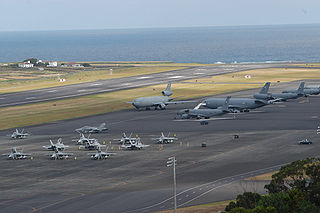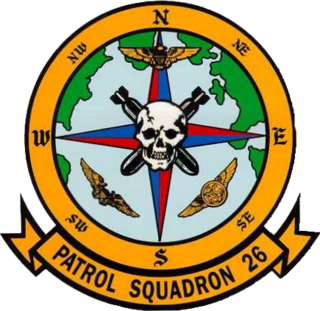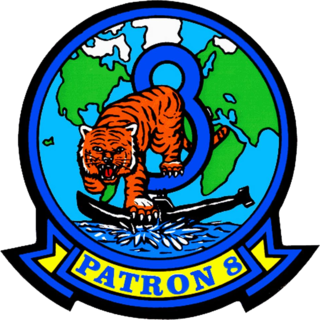Related Research Articles

In telecommunications, frequency-division multiplexing (FDM) is a technique by which the total bandwidth available in a communication medium is divided into a series of non-overlapping frequency bands, each of which is used to carry a separate signal. This allows a single transmission medium such as a microwave radio link, cable or optical fiber to be shared by multiple independent signals. Another use is to carry separate serial bits or segments of a higher rate signal in parallel.

Very low frequency or VLF is the ITU designation for radio frequencies (RF) in the range of 3–30 kHz, corresponding to wavelengths from 100 to 10 km, respectively. The band is also known as the myriameter band or myriameter wave as the wavelengths range from one to ten myriameters. Due to its limited bandwidth, audio (voice) transmission is highly impractical in this band, and therefore only low data rate coded signals are used. The VLF band is used for a few radio navigation services, government time radio stations and for secure military communication. Since VLF waves can penetrate at least 40 meters (131 ft) into saltwater, they are used for military communication with submarines.

Patrol Squadron 10 (VP-10) is a United States Navy Patrol Squadron based at Naval Air Station Jacksonville in Jacksonville, Florida, United States. It is nicknamed the "Red Lancers" and is equipped with the Boeing P-8A Poseidon. It is the third squadron to be designated VP-10. The first VP-10 was redesignated VP-2D15 on 21 September 1927 and the second VP-10 was redesignated VP-25 on 1 July 1939.

Naval Air Station (NAS) Sigonella is an Italian Air Force base, and a U.S. Navy installation at Italian Air Force Base Sigonella in Sicily, Italy. The whole NAS is a tenant of the Italian Air Force, which has the military and the administrative control. It serves as an Italian base for the 41º Stormo Antisom . NAS Sigonella acts also as landlord to more than 40 other U.S. commands and activities. It is located 15 km (8 NM) west and 11 km (6 NM) south of the city of Catania, and some 40 km (22 NM) south of Mount Etna.

Lajes Field or Lajes Air Base, officially designated Air Base No. 4, is a multi-use airfield near Lajes and 15 km (9.3 mi) northeast of Angra do Heroísmo on Terceira Island in the Azores, Portugal. It is home to the Portuguese Air Force Base Aérea N º4 and Azores Air Zone Command, a United States Air Force detachment unit, and a regional air passenger terminal. Located about 3,680 km (2,290 mi) east of New York City and about 1,600 km (990 mi) west of Lisbon, Portugal; the base sits in a strategic location midway between North America and Europe in the north Atlantic Ocean.

The Ground Wave Emergency Network (GWEN) was a command and control communications system intended for use by the United States government to facilitate military communications before, during and after a nuclear war. Specifically, the GWEN network was intended to survive the effects of an electromagnetic pulse from a high-altitude nuclear explosion and ensure that the United States President or their survivors could issue a launch order to Strategic Air Command bombers by radio.
Airband or aircraft band is the name for a group of frequencies in the VHF radio spectrum allocated to radio communication in civil aviation, sometimes also referred to as VHF, or phonetically as "Victor". Different sections of the band are used for radionavigational aids and air traffic control.
Shortwave bands are frequency allocations for use within the shortwave radio spectrum. Radio waves in these frequency ranges can be used for very long distance (transcontinental) communication because they can reflect off layers of charged particles in the ionosphere and return to Earth beyond the horizon, a mechanism called skywave or “skip” propagation. They are allocated by the ITU for radio services such as maritime communications, international shortwave broadcasting and worldwide amateur radio. The bands are conventionally named by their wavelength in metres, for example the ‘20 meter band’. Radio propagation and possible communication distances vary depending on the time of day, the season and the level of solar activity.
In the United States military's strategic nuclear weapon nuclear command and control (NC2) system, an Emergency Action Message (EAM) is a preformatted message that directs nuclear-capable forces to execute specific Major Attack Options (MAOs) or Limited Attack Options (LAOs) in a nuclear war. They are the military commands that the US military chain of command would use to launch a nuclear strike. Individual countries or specific regions may be included or withheld in the EAM, as specified in the Single Integrated Operational Plan (SIOP). The SIOP was updated annually until February 2003, when it was replaced by Operations Plan (OPLAN) 8044. Since July 2012, the US nuclear war plan has been OPLAN 8010-12, Strategic Deterrence and Force Employment.

The radio frequency 2182 kHz is one of the international calling and distress frequencies for maritime radiocommunication in a frequency band allocated to the mobile service on first priority ("primary") basis, exclusively for distress and calling operations.

Bellows Air Force Station is a United States military reservation located in Waimanalo, Hawaii. Once an important air field during World War II, the reservation now serves as a military training area and recreation area for active and retired military and civilian employees of the Department of Defense. Bellows AFS is operated by Detachment 2, 18th Force Support Squadron of the 18th Mission Support Group based at Kadena Air Base, Okinawa, Japan. Located on the opposite side of Oahu is the similar Pililaau Army Recreation Center, part of the Armed Forces Recreation Centers system.

Looking Glass is the historic code name for an airborne command and control center operated by the United States. In more recent years it has been more officially referred to as the ABNCP. It provides command and control of U.S. nuclear forces in the event that ground-based command centers have been destroyed or otherwise rendered inoperable. In such an event, the general officer aboard the Looking Glass serves as the Airborne Emergency Action Officer (AEAO) and by law assumes the authority of the National Command Authority and could command execution of nuclear attacks. The AEAO is supported by a battle staff of approximately 20 people, with another dozen responsible for the operation of the aircraft systems. The name Looking Glass, which is another name for a mirror, was chosen for the Airborne Command Post because the mission operates in parallel with the underground command post at Offutt Air Force Base.
An international distress frequency is a radio frequency that is designated for emergency communication by international agreement.

VP-23, Patrol Squadron 23, known as the Seahawks, was a U.S. Navy fixed-wing, anti-submarine and maritime patrol squadron based at Brunswick Naval Air Station, Brunswick, Maine, United States. It was established as Weather Reconnaissance Squadron Three (VPW-3) on 17 May 1946, redesignated as Meteorology Squadron Three (VPM-3) on 15 November 1946, redesignated Heavy Patrol Squadron (Landplane) Three (VP-HL-3) on 8 December 1947, and to Patrol Squadron Twenty Three (VP-23) on 1 September 1948 and disestablished on 28 February 1995. It was the second squadron to be designated VP-23, the first VP-23 was redesignated Patrol Bombing Squadron 23 (VPB-23) on 1 October 1944 and disestablished on 25 January 1946.

The VP-26 Tridents are a United States Navy aircraft squadron based at Naval Air Station Jacksonville in Florida. The squadron flies Boeing P-8A patrol aircraft. It was established as Bombing Squadron 114 (VB-114) on 26 August 1943 and renamed Patrol Bombing Squadron 114 (VPB-114) on 1 October 1944; Patrol Squadron 114 (VP-114) on 15 May 1946; Heavy Patrol Squadron (Landplane) 6 (VP-HL-6) on 15 November 1946, and Patrol Squadron 26 (VP-26) on 1 September 1948. The Tridents are the third squadron to be designated VP-26; the first VP-26 was renamed VP-102 on 16 December 1940, and the second VP-26 was renamed VP-14 on 1 July 1941.

Patrol Squadron Eight (VP-8) is a U.S. Navy land-based patrol squadron stationed at Naval Air Station Jacksonville, Florida (USA). VP-8 is tasked to undertake maritime patrol, anti-submarine warfare (ASW) (barely), and intelligence, surveillance and reconnaissance (ISR) missions. The Squadron is equipped with the Boeing P-8A Poseidon.

Commander, Naval Air Force Atlantic is the aviation Type Commander (TYCOM) for the United States Naval aviation units operating primarily in the Atlantic under United States Fleet Forces Command. Type Commanders are in administrative control (ADCON), and in some cases operational control (OPCON) of certain types of assets assigned to the Pacific and Atlantic Fleets. AIRLANT is responsible for the material readiness, administration, training, and inspection of units/squadrons under their command, and for providing operationally ready air squadrons and aircraft carriers to the fleet.
The Green Pine UHF communications system was designed to relay Strategic Air Command (SAC) Emergency Action Messages (EAMs) to SAC aircraft. Green Pine was designed in 1967. Each Green Pine station was equipped with a variety of communications systems, to ensure that nuclear command and control messages would reach nuclear strategic bombers in Northern latitudes.
References
- 1 2 3 "The HF-GCS and Emergency Action Messages". October 2014. Retrieved October 28, 2014.